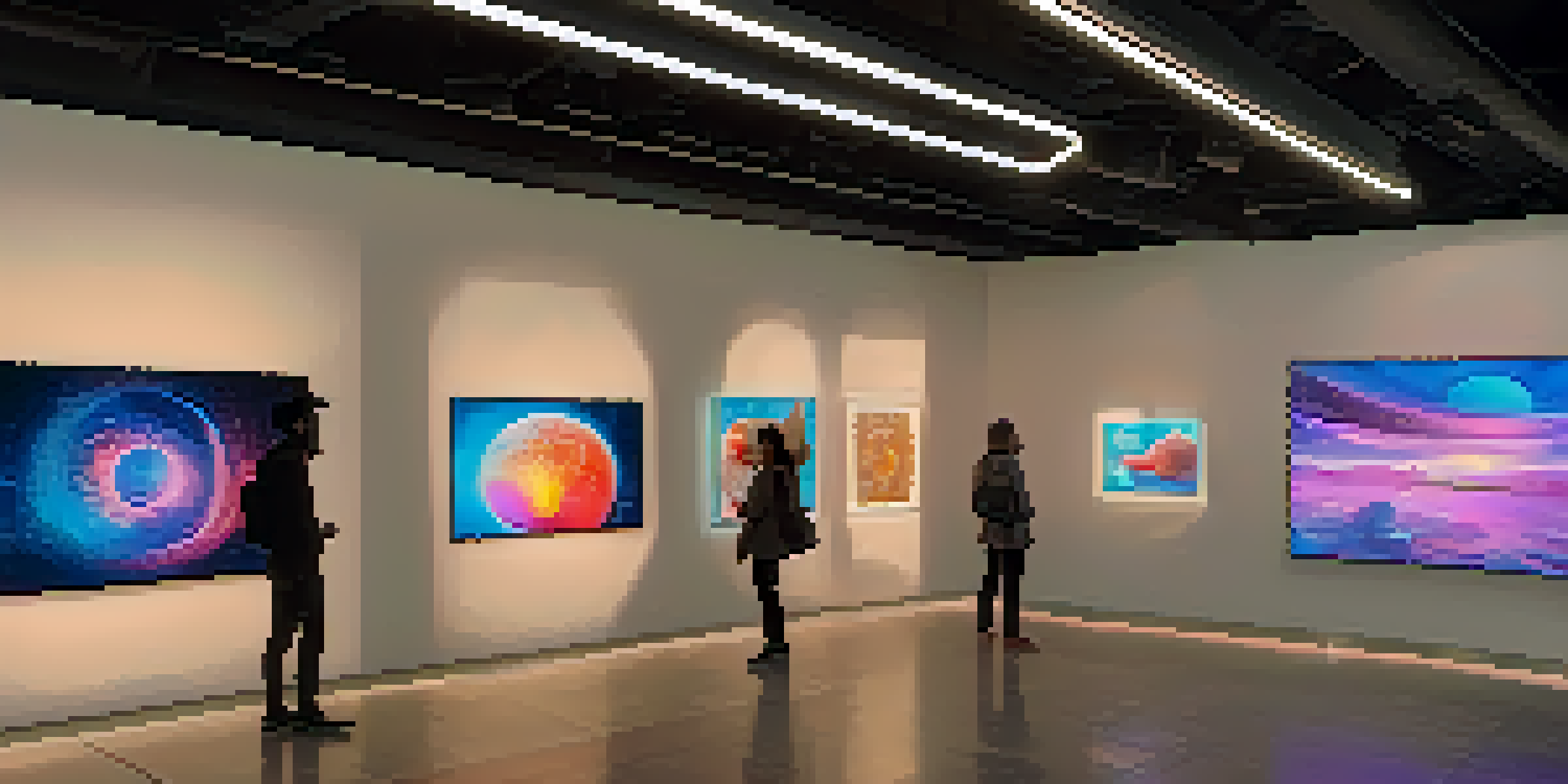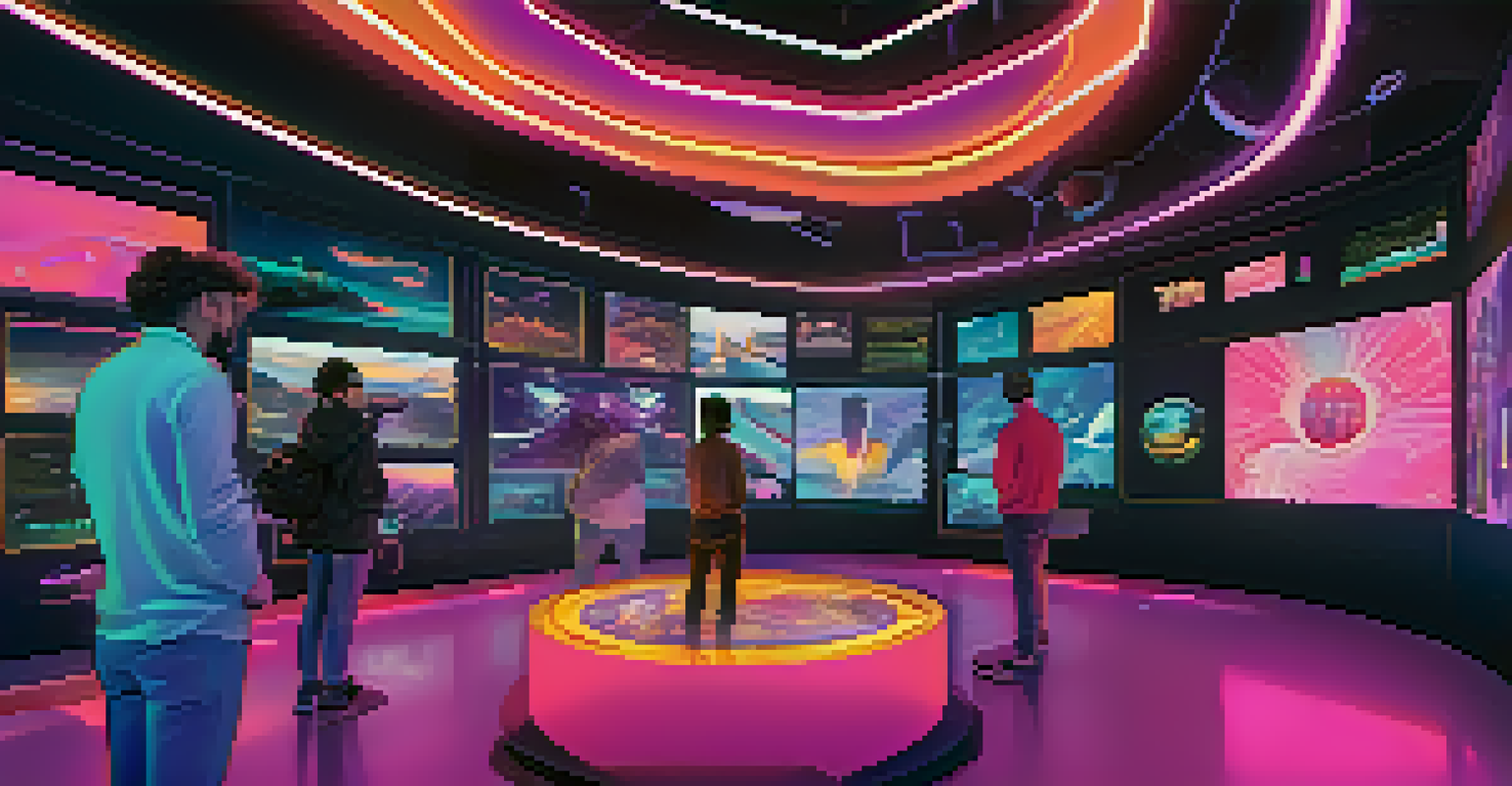The Evolution of NFT Marketplaces: Past, Present, and Future

Understanding NFTs: The Foundation of the Marketplace
Non-fungible tokens (NFTs) are unique digital assets that represent ownership of a specific item, often in art, music, and gaming. Unlike cryptocurrencies like Bitcoin, which are interchangeable, NFTs are one-of-a-kind, making them particularly appealing to collectors and creators. This uniqueness is secured through blockchain technology, ensuring transparency and authenticity.
NFTs have opened up a new frontier for digital ownership and creativity, allowing artists and collectors to connect in ways we never imagined.
The initial concept of NFTs emerged in 2017 with projects like CryptoPunks and CryptoKitties, which allowed users to buy, sell, and trade these digital collectibles. These early platforms laid the groundwork for what would eventually blossom into a robust market for digital assets. As the digital world evolved, so did the demand for ways to buy and sell these unique items.
Understanding NFTs is crucial because they sparked a new paradigm in ownership and digital creativity. As we delve into the evolution of NFT marketplaces, it’s important to see how this foundational concept has fueled the development of diverse platforms catering to various audiences.
The Rise of Early NFT Marketplaces: A New Frontier
The launch of early NFT marketplaces like OpenSea and Rarible in 2018 marked a significant step forward in making NFTs more accessible. These platforms provided users with an easy way to explore, purchase, and trade NFTs without the hassle of coding or technical knowledge. It was like opening a new gallery, where digital art could be showcased and sold to a global audience.

These marketplaces not only facilitated transactions but also fostered a community of creators and collectors. Artists began to realize they could monetize their work in new ways, while collectors found a thrilling new avenue for investment. The excitement around these early platforms helped to catalyze the growth of the NFT space, bringing more attention to the potential of digital ownership.
NFTs Revolutionize Digital Ownership
Non-fungible tokens (NFTs) have transformed the concept of ownership in the digital world, allowing unique assets like art and music to be bought and sold securely on blockchain technology.
However, these early marketplaces were not without their challenges. Issues such as high gas fees, limited payment options, and a lack of user-friendly interfaces highlighted the need for further innovation in the space. This laid the groundwork for subsequent developments and improvements in NFT marketplaces.
Mainstream Adoption: NFTs Enter the Spotlight
The turning point for NFT marketplaces came in 2020 when high-profile sales and celebrity endorsements catapulted NFTs into popular culture. Pieces like Beeple’s digital artwork selling for $69 million at Christie’s caught the attention of not only investors but also the general public. It was as if a new art movement had emerged overnight, captivating audiences worldwide.
The future of NFTs lies in their ability to redefine what value means in the digital world, creating not just collectibles but also experiences.
This surge in interest led to an influx of platforms catering to various niches, from art and music to virtual real estate. Marketplaces began to diversify, offering unique features like fractional ownership and auction options, which appealed to a broader audience. Suddenly, anyone could be a collector or investor in this exciting new digital realm.
As mainstream adoption grew, so did the need for education and clarity in the NFT space. Platforms started to provide resources and guides to help newcomers navigate the complexities of buying and selling NFTs, fostering a more inclusive environment. This evolution marked a significant step in legitimizing NFTs and embedding them into the fabric of digital culture.
Current Landscape: A Diverse Ecosystem of Marketplaces
Today, the NFT marketplace landscape is rich and varied, with platforms like Foundation, SuperRare, and Nifty Gateway catering to different audiences and types of digital assets. Each has its unique selling points, whether it’s a focus on high-quality art, community-driven projects, or exclusive drops. It’s akin to a bustling marketplace, where every stall offers something distinct.
With this diversity comes competition, pushing platforms to innovate and enhance user experience continually. Features like gasless transactions, social media integration, and enhanced security measures are becoming standard as users demand more from their marketplace experiences. This competitive spirit benefits both creators and collectors, leading to a more vibrant ecosystem.
Emergence of Diverse Marketplaces
The rise of various NFT marketplaces has made digital assets more accessible, catering to different audiences and encouraging a thriving community of creators and collectors.
Moreover, the rise of secondary markets has allowed creators to earn royalties every time their art is resold, creating a sustainable income model. This shift not only incentivizes artists but also enriches the entire marketplace's culture, emphasizing support and collaboration over mere transactions.
Challenges Facing NFT Marketplaces: What’s Next?
Despite their growth, NFT marketplaces face several challenges, such as environmental concerns associated with blockchain technology and the volatility of the crypto market. Critics have raised questions about the sustainability of NFTs, urging platforms to seek greener solutions. This has sparked a conversation around the need for more eco-friendly practices within the NFT space.
Additionally, issues related to copyright infringement and fraud have surfaced, raising concerns about the protection of artists and buyers alike. As the market becomes saturated with offerings, ensuring authenticity and ownership rights is paramount. Marketplaces are now prioritizing measures to tackle these issues, emphasizing the importance of trust and security.
The future of NFT marketplaces will likely hinge on their ability to adapt to these challenges while continuing to innovate. As the technology evolves, so too will the platforms, potentially integrating new features that enhance user experience and trust. This adaptability will be crucial for sustaining growth and maintaining a positive trajectory in the NFT ecosystem.
The Future of NFT Marketplaces: Trends to Watch
As we look ahead, several trends are emerging that could shape the future of NFT marketplaces. One such trend is the integration of virtual and augmented reality, creating immersive environments for buyers to explore digital assets. Imagine walking through a virtual gallery, experiencing art in a whole new way—this could redefine how we interact with NFTs.
Interoperability between different blockchain networks is another trend gaining traction. This would allow NFTs to be easily transferred and traded across various platforms, enhancing liquidity and accessibility. Such developments could open up a world of possibilities, making it easier for users to engage with their digital assets.
Future Trends in NFT Marketplaces
Emerging trends such as virtual reality integration and interoperability between blockchains are set to redefine how users interact with NFTs and expand their functionalities.
Finally, the potential for NFTs to evolve beyond art and collectibles into functional assets, such as virtual real estate or tokenized experiences, is fascinating. As creators and technologists continue to push boundaries, we may see NFT marketplaces transform into comprehensive ecosystems that offer a range of services and experiences, making them an integral part of our digital lives.
Conclusion: Embracing the Evolution of NFT Marketplaces
The evolution of NFT marketplaces reflects a broader shift in how we perceive ownership and value in the digital age. From their humble beginnings to their current diverse ecosystem, these platforms have transformed into vibrant communities where creativity and commerce intersect. Embracing this evolution allows us to appreciate the potential of digital assets while recognizing the challenges that lie ahead.
As we continue to explore the potential of NFTs, it’s essential to remain informed and engaged. Understanding the nuances of this evolving landscape will empower both creators and collectors to navigate the opportunities and challenges presented. The future holds exciting possibilities, and being part of this journey can lead to a deeper appreciation of digital creativity.

In conclusion, the story of NFT marketplaces is just beginning. By keeping an eye on trends and embracing innovation, we can look forward to a thriving ecosystem that celebrates creativity and redefines our relationship with digital assets.